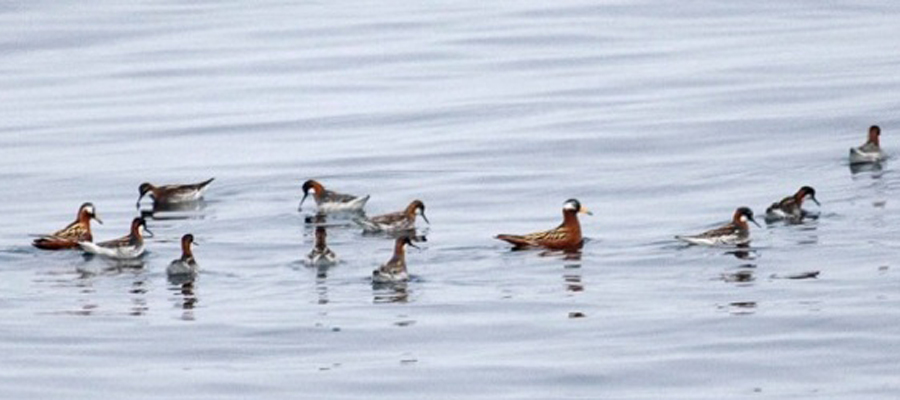PHALAROPES
If you are a birdwatcher you probably already know that Phalaropes are a small (both in size and number of species) family of birds with only three species making up the entire genus. They breed on the shores of ponds and lakes in the Arctic during Summer and Winter at sea.
There are a total of three species of Phalaropes: the Red-necked Phalarope (formerly “Northern phalarope” and I often times still say it out of habit which confuses birders onboard), the Red phalarope (also called “Grey phalarope in Europe. They are mostly red in breeding plumage and mostly grey in non-breeding), and the Wilson’s Phalarope (why don’t they get another name?).
All three Phalarope species can be seen in Massachusetts, although only two of these species, Red-necked and Red, are likely to be seen at sea. The Wilson’s phalarope is found in wet, grassy fields and mudflats along the coast but virtually never in the open ocean.
A mixed flock of Red-necked and Red phalaropes on Jeffrey’s Ledge (the northern part of Stellwagen Bank National Marine Sanctuary). I bet you can figure out which species is which!
Phalaropes are closely related to “sandpipers” but different in some significant ways. Opposite of most birds, female are much more brilliantly colored than the males, and it is the males that sit in the nest and incubate the eggs.
Red-necked and Red phalaropes are superbly adapted to a life at sea. Like the Shearwaters and Petrels they have special salt-filtering glands which enable them to drink seawater, they have extra-thick feather which trap air and make them float like corks on top of the water, and they have lobed feet that enable them to swim with great agility.
A typical view of Phalaropes at sea. They often take-off before you are able to get a close look, making basic plumage (aka “Winter plumage”) birds difficult to identify. In general, 99.9% of Phalaropes seen in our are are Red-necked.
Phalaropes are often found in large flocks swimming amongst “wrack lines” (lines of seaweed and other debris that accumulates where currents meet) darting about erratically or spinning in circles as they hunt for aquatic invertebrates to eat.
Identification of Phalaropes seems as if it should be easy andstraightforwardd when you look at pictures of them in a bird guide. There are clear differences in both breeding and non-breeding plumage as well as bill-shape and over all body proportions. The problem is that the birds are very small (not much larger than sparrows) and they often will take-off before an approaching boat can get an observer close enough to pick through the flock looking for representatives of both species. To see what I mean take a QUICK glance at the photo below and try to pick out the two Red phalaropes in this flock (and this is a heavily cropped photo. The actual flock was much larger!)
As far as abundance is concerned, only the Red-necked phalarope is common in our area. They are seen mostly in Spring and Fall while migrating to-or-from their breeding ground in the far north to distant, offshore wintering grounds in the central and souther Atlantic Ocean. Red phalaropes are very rare, with only one large incursion of these beautiful birds in recent years (Spring of 2012 when hundreds were seen following a large ocean storm that must have blown these birds westward towards the coast from far offshore).





